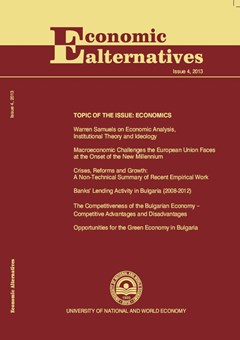Banks’ Lending Activity in Bulgaria (2008-2012)
Author: Ekaterina Sotirova
Abstract
Bulgaria’s economic development over the past years has been the result of the global and national economy crisis alike. The decline in business activity and the sputtering revival have affected the state and the dynamics of lending and the interest rates are one specific factor of very high importance in this respect. In the middle of 2013 there were 24 commercial banks and 7 branches of foreign banks which performed in Bulgaria. The number of performing banks is not in direct proportion to the extended loans. On the one hand, the banks’ activity is characterized with slow and sluggish growth rate – between 1 – 3% annually since 2010. The reasons for that are: banks have strong requirements to extending credits of companies and of householders business’s unsatisfactory investment activity based on pessimistic expectations, low household incomes which affects the demand for credit. On the other hand, under the current circumstances the commercial banks estimate relatively higher risk premiums on interest rates, thus limiting the opportunities for using borrowed capital.

